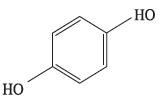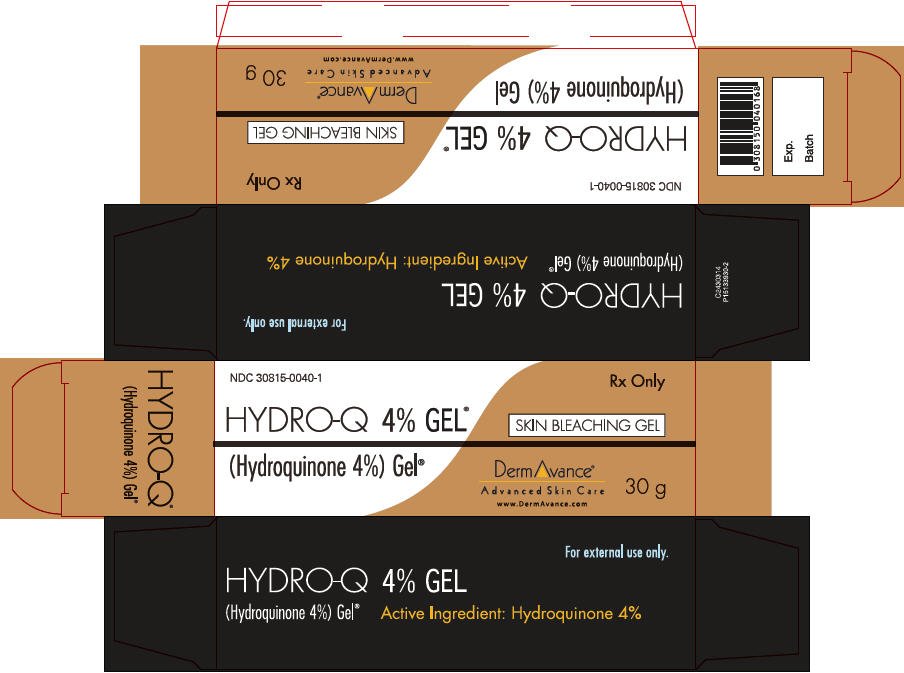Hydro-Q: Package Insert / Prescribing Info
Package insert / product label
Generic name: hydroquinone
Dosage form: gel
Drug class: Topical depigmenting agents
Medically reviewed by Drugs.com. Last updated on Jan 6, 2025.
On This Page
HYDRO-Q® contains hydroquinone USP 4%. Hydroquinone is 1, 4-Benzenediol {CAS 123-31-91}. Hydroquinone is structurally related to monobenzone. Hydroquinone occurs as fine white needles. The drug is freely soluble in water and in alcohol and has a pKa of 9.96. Chemically, hydroquinone is designated as p-dihydroxybenzene; the empirical formula is C6H6O2; The molecular weight is 110.1. The structural formula is:

ACTIVE INGREDIENT
Hydroquinone USP 4%
OTHER INGREDIENTS: Purified water, Carbomer 940, Sodium Metabisulfite, Sodium Hydroxide, Methylparaben, Edetate Disodium.
Hydro-Q - Clinical Pharmacology
Topical application of hydroquinone produces a reversible depigmentation of the skin by inhibition of the enzymatic hydroquinone. oxidation of tyrosine to 3, 4-dihydroxyphenylalanine (dopa) 1 and suppression of other melanocyte metabolic processes. Exposure to sunlight or ultraviolet light will cause regimentation of the bleached areas.
Indications and Usage for Hydro-Q
HYDRO-Q® is indicated for the gradual bleaching of hyperpigmented skin conditions such as chlosma, melasma, freckles, senile lentigines and areas of melanin hyperpigmentation.
Contraindications
HYDRO-Q® is contraindicated in any patient that has a prior history of sensitivity or allergic reaction to hydroquinone or any of the other ingredients. The safety of topical hydroquinone use during pregnancy or in children (12 years and under) has not been established.
Warnings
- CAUTION: Hydroquinone is a depigmenting agent that may produce unwanted cosmetic effects if not used as directed. The physician should be familiar with the contents of this insert before prescribing or dispensing this medication.
- Test for skin sensitivity before using HYDRO-Q® by applying a small amount of the gel to an unbroken patch of skin and check within 24 hours. Minor redness is not a contraindication but where there is itching and vesicle formation or excessive inflammatory response further treatment is not advised. Close patient supervision is recommended. Contact with the eyes should be avoided. If no lightening effect is noted after 2 months of treatment the use of HYDRO-Q® should be discontinued. HYDRO-Q® is formulated for the treatment of dyschromia and should not be used for the prevention of sunburn.
- Sunscreen use is an essential aspect of hydroquinone therapy because even minimal sunlight sustains melanocytic activity. To prevent repigmentation during treatment and maintenance therapy, sun exposure on treated skin should be avoided by application of a broad spectrum sunscreen SPF 15 or greater) or by use of protective clothing
- Keep this and all medications out of reach of children. In case of accidental ingestion, contact a physician or a poison control center immediately.
- WARNING: Contains sodium metabisulfite, a sulfite that may cause serious allergic reactions (e.g., hives, itching, wheezing, anaphylaxis, severe asthma attack) in certain susceptible persons
- On rare occasions, a gradual blue-black darkening of the skin may occur, in which case, use of HYDRO-Q® should be discontinued and a physician contacted immediately
Precautions
See Warnings
A. Pregnancy Category C
Animal reproduction studies have not been conducted with topical hydroquinone. It is also not known whether hydroquinone can cause fetal harm when used topically on a pregnant woman, or can affect reproductive capacity.
Adverse Reactions/Side Effects
No systemic reactions have been reported. Occasional cutaneous hypersensitivity (localized contact dermatitis) may occur, in which case the medication should be discontinued and the physician notified immediately
Related/similar drugs
Overdosage
There have been no systemic reactions reported from the use of topical hydroquinone. However, treatment should be limited to relatively small areas of the body at one time, since some patients experience a skin reddening and a mild burning sensation that does not preclude treatment
Hydro-Q Dosage and Administration
HYDRO-Q® should be applied to the affected areas twice daily, morning and before bedtime or as directed by a physician.
During and after the use of HYDRO-Q®, sun exposure should be limited and a sunscreen agent or protective clothing should be used to cover up the treated areas to prevent regimentation. If no lightening effect is noted after two months of treatment, use of HYDRO-Q® should be discontinued. There is no recommended dosage for children under the age of 12 years of age except under the advice and supervision of a physician.
How is Hydro-Q supplied
HYDRO-Q® (Hydroquinone 4%) Gel is supplied in a 30 g tube.
NDC: 30815-0040-1
References
- Denton C, Fitzpatrick TB, Lerner AB. Inhibition of melanin formation by chemical agents. J Invest Dermatology. 1952; 18: 119-135.
- Fitzpatrick TB, Jimbow K, Obata M, Panthak M. Mechanism of depigmentation by hydroquinone. J Invest Dermatology. 1974; 62: 436-449.
- Anderson RR, Parrish JA, Pitts D, Urbach F. UVA, Biological Effects of Ultraviolet Radiation With Emphasis on Human Responses to Longwave Ultraviolet. New York and London: Plenum Press; 1978: 151.
| HYDRO-Q
hydroquinone gel |
||||||||||||||||||||
|
||||||||||||||||||||
|
||||||||||||||||||||
|
||||||||||||||||||||
|
||||||||||||||||||||
|
||||||||||||||||||||
| Labeler - Dermavance Pharmaceuticals (046042475) |
| Establishment | |||
| Name | Address | ID/FEI | Business Operations |
|---|---|---|---|
| Medical Products Laboratories, Inc. | 002290302 | MANUFACTURE(30815-0040) | |
More about Hydro-Q (hydroquinone topical)
- Compare alternatives
- Latest FDA alerts (1)
- Side effects
- Dosage information
- During pregnancy
- Drug class: topical depigmenting agents
- Breastfeeding
Professional resources
Other brands
Melamin, Lustra, Melquin HP, Glytone Skin Lightening, ... +3 more

